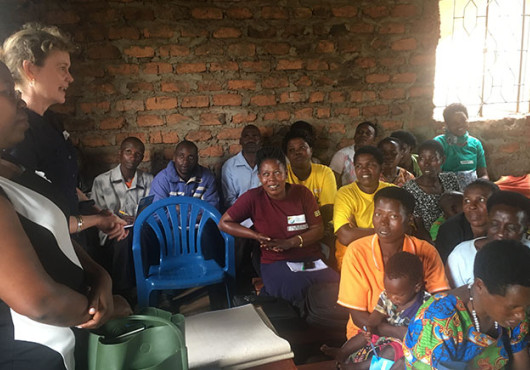
Image: sudok1/iStock/Getty Images Plus
In what is believed to be one of the largest analyses of surgical quality improvements in Africa, a large multipartner study that included the Program in Global Surgery and Social Change at Harvard Medical School has identified the secrets to success for optimizing surgical quality.
The most important among them: Building teamwork and a culture of collective learning are key for high performance.
The results of the effort, based on data from 10 hospitals in Tanzania implementing a program called Safe Surgery 2020, are published in BMJ Quality & Safety.
This latest work is part of an ongoing effort to improve surgical care in sub-Saharan Africa, where 93 percent of the population lacks access to safe, effective, and timely surgical, obstetric, and anesthesia care.
That puts the region at the epicenter of a global crisis that leaves 5 billion people without the lifesaving surgical care needed to treat injuries and disease, according to the 2015 Lancet Commission on Global Surgery.
Studies find high levels of excess morbidity and mortality resulting from poor surgical quality in African countries, where patients are twice as likely to die after surgery compared with the global average, despite being younger, having a lower surgical risk profile, and undergoing less complex surgical procedures.
“We can do better, and we must,” said John Meara, director of the Program in Global Surgery and Social Change at HMS and principal investigator of the study. “Effective and scalable strategies for improving surgical quality for the world’s poorest are urgently needed.”
The newly published analysis is based on data collected over 12 months in a capacity-building program designed to improve surgical quality.
The researchers collected quantitative data about safety practices and outcomes and also conducted qualitative interviews with surgical teams and leaders about their perceptions and experiences throughout the process.
While all groups showed improvements, a few elements set the top performers apart. Using a methodology known as positive deviance analysis, an approach that seeks to identify factors that can help an organization succeed at a difficult task, the researchers looked at how perceptions and experiences differed between the institutions that showed the most improvement on quality metrics and those that showed less.
The facilities with the greatest improvement started out by emphasizing cultural changes that would encourage teamwork and collective learning before they implemented specific techniques and tools.
Those cultural shifts appear to have made it easier to then deploy things like surgical safety checklists and other tools and practices designed to improve safety, said co-author Shehnaz Alidina, senior global health systems researcher in the Program in Global Surgery and Social Change at HMS.
By contrast, lower performing facilities focused on implementing specific new techniques and practice changes early in the process and made slower progress on cultural changes such as teamwork and collective learning.
While efforts to improve surgical quality often focus on teaching and implementing specific clinical interventions and technical skills, investing in nontechnical skills including teamwork and communication and collective learning may be critical to improving surgical quality, the researchers said.
The findings suggest that tailoring interventions to facility context through preintervention assessments and strong leadership engagement can facilitate successful implementation of safe surgery interventions.
Addressing a critical shortage
The 2015 Lancet Commission report galvanized a global movement of surgeons, researchers and advocates for global health equity who were not content to only document the human suffering brought on by the global surgical shortage. Instead, the commission launched a number of efforts to build the required surgical capacity around the world.
One of those efforts is Safe Surgery 2020, a collaborative effort of the Government of Tanzania, PGSSC, Dalberg, Jhpiego, and Assist International.
Since 2016, Safe Surgery 2020 has been deploying an innovative training and mentorship model including surgical infrastructure strengthening with projects in place in Ethiopia, Tanzania, and Cambodia.
As the monitoring and evaluation arm of the collaborative, PGSSC has produced a number of reports and publications summarizing the goals and impact of Safe Surgery 2020.
To date, PGSSC researchers have published early lessons learned in safe surgery partnerships with the Ministry of Health in Ethiopia, designed a robust quasi-experimental study to evaluate the impact of surgical care interventions in Tanzania, and presented baseline findings of a newly implemented safe surgery training model in Cambodia.
Initial evaluations of the project in Tanzania showed that the model worked, with all facilities making significant improvements in adherence to practices and behaviors that promote surgical safety and prevent maternal sepsis.
But researchers also found that some facilities had much better results than others. With so much at stake, and resources so limited, the researchers wanted to know what the secret to a successful implementation might be.
While interventions to improve surgical quality are growing, knowledge on how best to improve surgical quality in low-and middle-income countries is scant, said Ntuli Kapologwe, senior author of the study, noting that studies to improve surgical quality typically report outcomes, but not variation in outcomes across health facilities nor causes of the variation.
Kapologwe is also director of the Department of Health, Social Welfare and Nutrition Services in the President’s Office, Regional Administration and Local Government in Tanzania.
“The same intervention can have very different outcomes in different facilities,” said Pritha Chatterjee, a doctoral student in the Department of Social and Behavioral Sciences at the Harvard T.H. Chan School of Public Health and co-author of the study.
“We need to understand why interventions to improve surgical quality do not work to the same degree in similar settings.”
Funded by the GE Foundation, Safe Surgery 2020 is a global initiative that aims to improve surgical systems in low- and middle-income countries through capacity building.
Using an innovative training and mentorship model, Safe Surgery 2020 focuses on four key areas of surgical systems strengthening: leadership and teamwork, evidence-based practices in safe surgery, anesthesia and sterilization, data quality, and infrastructure. Since 2016, Safe Surgery has implemented various programs in Ethiopia, Tanzania, and Cambodia.
For the BMJ Safety and Quality study, the researchers conducted a positive deviance analysis using qualitative data from 100 interviews with leadership and surgical team members to illuminate the factors that facilitated higher performance. The study is believed to be one of the largest surgical quality improvement studies in an African setting.
Surgical teams in higher performing facilities emphasized open communication, less hierarchy, and collective responsibility for patients. They placed an emphasis on knowledge translation within their facility, used data for monitoring performance, and proactively managed gaps.
The researchers described several examples, including one facility that developed a monthly report card system to follow the care of randomly selected surgical patients to grade whether the patients followed the best practices prescribed by Safe Surgery.
In another facility, when patients experienced an increase in surgical-site infections, the surgical team went as a group to examine patients in the postsurgical ward, performed spot-checks to assess hygiene and sterilization practices, double-checked to see if the surgical safety checklist had been used, then triangulated information across patients on these and other factors to try to find an explanation for the increase in infections and improve processes to prevent further infections.
The researchers also found that leaders in higher performing facilities were able to devote more time to daily Safe Surgery tasks. In lower performing facilities, even though leaders were committed to implementing the program, they played largely supervisory roles.
“Our analysis has provided a more comprehensive understanding of factors that can help policymakers, funders, and practitioners in planning effective interventions,” said Sarah Maongezi, coordinator of adult noncommunicable disesases in the Tanzania Ministry of Health, Community Development, Gender, Elderly and Children and the Tanzanian principal investigator for the Safe Surgery 2020 study.
Financial support for this research was provided through grants from the GE Foundation and Elma Philanthropies.
Additional co-authors from Harvard Medical School, Harvard T.H. Chan School of Public Health, Tanzania National Institute for Medical Research Mwanza Research Centre, GE Foundation, JHPIEGO, Bugando Consultant and Referral Hospital, Dalberg Advisors, Muhimbili University of Health and Allied Sciences, Assist International, Tanzania Department of Health, Social Welfare and Nutrition Service, Tanzania Department of Adult Non-Communicable Diseases, Tanazania Ministry of Health contributed to this study.





